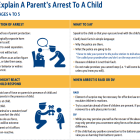
Schools, Like Courts, Turning Away From Sledgehammer Responses
|
We fling sledgehammers in the form of zero tolerance. We use suspensions, expulsions and arrests to rid our schools of disruptive students. When did making adults mad become a crime?
Juvenile Justice Information Exchange (https://jjie.org/page/216/)

In late September, Torri was driving down the highway with her 11-year-old son Junior in the back seat when her phone started ringing.
It was the Hamilton County Sheriff’s deputy who worked at Junior’s middle school in Chattanooga, Tennessee. Deputy Arthur Richardson asked Torri where she was. She told him she was on the way to a family birthday dinner at LongHorn Steakhouse.
“He said, ‘Is Junior with you?’” Torri recalled.
Earlier that day, Junior had been accused by other students of making a threat against the school. When Torri had come to pick him up, she’d spoken with Richardson and with administrators, who’d told her he was allowed to return to class the next day. The principal had said she would carry out an investigation then. ProPublica and WPLN are using a nickname for Junior and not including Torri’s last name at the family’s request, to prevent him from being identifiable.
When Richardson called her in the car, Torri immediately felt uneasy. He didn’t say much before hanging up, and she thought about turning around to go home. But she kept driving. When they walked into the restaurant, Torri watched as Junior happily greeted his family.
Soon her phone rang again. It was the deputy. He said he was outside in the strip mall’s parking lot and needed to talk to Junior. Torri called Junior’s stepdad, Kevin Boyer, for extra support, putting him on speaker as she went outside to talk to Richardson. She left Junior with the family, wanting to protect her son for as long as she could ...

We fling sledgehammers in the form of zero tolerance. We use suspensions, expulsions and arrests to rid our schools of disruptive students. When did making adults mad become a crime?

Each year in the United States, several million children witness the arrest of a parent.
These arrests are most likely to be for domestic violence, drug-related incidents and property crimes, according to a report from the Office of Justice Programs Diagnostic Center, an agency of the U.S. Department of Justice.
The experience can be excruciating for children.
NEW YORK — More than 40 national and state organizations dedicated to juvenile justice reform posted a joint letter to Gov. Andrew Cuomo and the state legislature on the need to raise the age of criminal responsibility to 18.

The recent suicide of Kalief Browder, a one-time inmate held in the adolescent jail on notorious Rikers Island, is a wake-up call to stop treating youth in our justice system as if they were adults.
A bill to reauthorize the Juvenile Justice and Delinquency Prevention Act was introduced today in the U.S. House of Representatives by Rep. Bobby Scott, D-Va.
Many people who work with adolescents are concerned that a lack of education and information when they come of age sexually might be contributing to the rise in the HIV infection rate.
“We teach young children how to brush their teeth. Why wouldn’t we teach them to take care of their penis?” asked Maisha Drayton, senior director of staff development and a counselor at Evergreen Health Services in Buffalo, N.Y.
Thomas Davis, 23, also a youth ambassador at the Portland conference, said outreach from the medical community is important.
“In 2015, there’s no excuse for us to not have the information we need. This is an issue that involves all of us.”

“About 50 percent of the patients we get are Latino males,” said Belzer. “Then another 35 to 40 percent are African-American [males]. In Los Angeles, they combine to make about 20 or 25 percent of the total population, so the disparity is very clear.”

Economist and author Noreena Hertz created the name from that generation’s “Hunger Games” icon, Katniss Everdeen, after surveying 1,000 British and American girls.